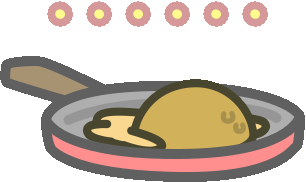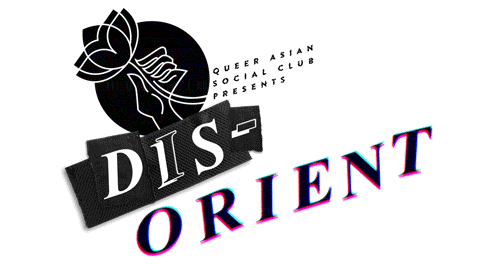


WINTER 2020 VOL. 1 ISSUE 6 | DEC 18, 2020

After my first queer break-up, I lost my appetite for a full four months. When I arrived at my parents' doorstep with all my belongings in my car (#UHaulLesbians), they asked me no questions and I provided no answers, yet somehow we all knew what had happened. Alone in my room, I would endlessly cry while Googling things like, "what to do when you get cheated on." My mom would call me for dinner, and I would wipe my face, take a deep breath, and pretend everything was ok. Inevitably, eating would make me cry again. I tried to hide it in front of my parents, but the condemning tears stubbornly betrayed me. When I couldn't finish my meal, I told my mom that I had a stomachache. I could feel my mom looking at me with a concern deeper than either of us knew how to communicate. For the next four months, every day she made me jook 죽, a Korean porridge eaten when sick. Dotted with carefully chopped carrots and Korean zucchini, it tasted like all the conversations we didn't yet know how to have.
"Food as love" has been a common theme this season of DIS-ORIENT. For so many of us, food is a love language that can be tasted when words fail and cultures collide—a common ground where we can examine the ingredients of our identities. This week's issue of DIS-ORIENT brings us perspectives through sweetness, featuring "Sugar" by Jazlyn Patricio-Archer, Art by Wednesday Blue, "June Pantoum" by May Li Hong, "Baked Niangao is Butter Mochi is Bibingka in America" by Jess Wang, and your weekly Celestial Reading by Ian Simmons-Francisco.
Sometimes food is nourishment in more ways than one. We hope this issue of DIS-ORIENT fills your belly with the dessert (or jook 죽) of being fully seen and fully held.
FOOD AS LOVE, LOVE AS FOOD

.png)


ILLUSTRATIONS BY PEYTON EMERY
BY JAZLYN PATRICIO-ARCHER




It would be remiss not to mention that there’s power in sweetness —and power is power. We must steward it like we steward this earth. We make weapons; we make homes; we make borders; we make families.
.png)
There was a sliding glass door in the middle of the house. It was where the house used to end before I was born. On the other side of the door is where I grew up—the extension. The extension had a seventies feel to it like the rest of the house, even though it was built in the nineties.
There was a window in the wall of the kitchen that used to open to the outside. My grandmother Ma is not quite five feet tall, so we couldn’t see her through it, but her nonsensical hum would carry through the house whenever she was in there. We would climb up onto edge of the couch that hugged the speckled wall, the walls that were still the texture of the outside of a house, and we’d poke our heads over the ledge to tell her we were hungry.
The couch was L-shaped and brown, and the carpet was ugly and orange. My cousins and I would rip the cushions off the couch and line the floor between the sections into a makeshift bed where we could all pile on and fall asleep laughing at the infomercials that came on past eleven on the Food Network.
Those times when we piled together in the extension to sleep, we would always wake up to the sweet smell of toasting bread—four pairs of eyes sleepily blinking awake when Ma would sing-song, “Cinnamon a soo-gar toast!”
I usually got up first, and slid into the kitchen across the laminate wood floor. When they put the laminate in, I remember the adults saying that the wood was fake, but it was just as good. Ma would be standing over a bowl lined with white sugar crystals, swirling it with streaks of golden cinnamon.
“That’s it?” I would ask. It was too simple for how good it was.
“Butter and sugar. That’s it.”
“That’s it,” I would echo, watching her undo the twist on the very white sweet bread wrapped in blue plastic from Ocean Market.
I’m a farmer-in-training. Farmer, for a lot of reasons, is a hard title to claim, but it feels important that I do it. We’ve always been farmers; we just forgot because of all of the awful things we were forced to do to the land.
The first record of sugarcane domestication dates back to 8000 B.C. in what is now New Guinea. I had a teacher who described the process of domestication as generations of grandmothers choosing the plants that would best feed their babies. Twenty six generations later, sugarcane was recorded in the Philippines and India.
Crops are marked by their origin stories. When we don’t know where things came from, we leave gaps in our knowledge—and people like us die from lack of knowledge. A crop like sugar, which has led so many lives, been touched by so many grandmothers, and stolen by so many colonizers, has many stories of origin.
Sugar was reborn as empire when the feudal Lady of La Gomera, Doña Beatriz de Bobadilla y Osorio, had an affair with Christopher Columbus. She gave him sugarcane as a parting gift—a sweet send-off. He brought it to Hispañola where he exploited ancient, sacred growing practices to amass a fortune using the bodies of Afro-Indigenous people as fuel to the machine. When he ran out of bodies, he began to import them.
Another origin: this time as false hope. The story starts the same—another island stolen from its people; a war with which they had nothing to do, but whose burdens they would bear nonetheless. This one was the American Civil War and the people were Hawaiʻi maoli. The South wouldn’t ship sugar north, so the North manipulated Hawaiian laws to allow white men to claim ownership of land that had owned itself since the beginning of time.
After looking out at the Hawaiian people, whose population was down to one sixth of its pre-imperial size because of disease brought through the blood of intruders, they determined that they would need to import a labor force to support the demand.
The migration wasn’t forced—it wasn’t the same as slavery, and it’s not right to equate the two. The Chinese, Japanese, and Filipino immigrants who answered the sugar’s call came because they thought it would be a new beginning. There’s hope in that. There’s some truth in it, too. And also, plantation workers were bound by 3- to 5-year contracts and conditions were shit. Deserters were jailed. Freedom is fickle.
Okay, one more:
My grandmother was born on the Hamakua coast on the island of Hawai’i in 1947, a few months after the start of the sugar plantation strike that would eventually send our family back to the Philippines for two more decades.
I texted her the other day. How do you say sugarcane in Ilocano? We called it unás, she wrote back, right away, like she’d been waiting for me to ask.
A crop like sugar, which has led so many lives, been touched by so many grandmothers, and stolen by so many colonizers, has many stories of origin.
.png)



“Just because we’ve been letting them kill us doesn’t mean we should keep letting them kill us because it’s, like, tradition.”



I used to have a type. I got over it. I matched with this guy on some app who opened with, “Could you tell I’m Filipino, too?”
He was half Mexican and I am half white. Culturally, he was mostly Mexican and I was mostly Filipino, which kept him from claiming his identity in the way that my light skin kept me from claiming mine. I liked him for a lot of reasons, but I think I liked him most for how he borrowed Tagalog words with the same, sneaking hesitancy as I did. We had both spent a lifetime unsure if we were allowed. We talked to each other about being Filipino like it was a confession.
There was one confession made over the stove in my kitchen during our fourth date:
I couldn’t move away from the onions I was caramelizing for a curry roux. I was making a high-maintenance dish to impress and test him in one go. I don’t respect people who are useless at cooking because they’d starve in the apocalypse, so it was a good sign that he was keeping up.
“It’s just so—sad, like it’s fucked up,” I ranted. “I asked my grandma how to make sinigang from scratch and she was just like, it tastes the same with the packet. It’s like, we’ve learned that Filipino food is supposed to taste like the powdered mixes pumped with sugar and MSG.”
He was washing the vegetables at the sink, scrubbing carrots with his palms. “I mean, not to play devil’s advocate—” He must have seen the ugly look on my face at a man advocating for the devil in my home, because he doubled back and corrected, “No, seriously, I get it, I’m just pushing back because I’ve seen—like, my aunt says the same thing when I’ve asked how to make things.”
“It’s fucked up,” I repeated, stubborn. “It’s because the colonizers industrialized our cultural practices and then sold them back to us, except full of shit that’ll kill us.”
(I am bad at dating.)
“I mean, yeah,” he said, slowly. “I think people are used to doing things a certain way and —that’s important? The sugar, the MSG— it’s like, a part of it. A bad part, but still.”
I stirred the onions, which were starting to transform from translucent strings to the sweet brown paste that would make up the base of the curry. The first time I did this, I was completely transfixed. I’d only made curry from the curry bricks before, the shady ones that come in those ice cube tray contraptions and can sit on shelves for years without decay.
My arrogant, obstinate brain would not let it go. “Just because we’ve been letting them kill us doesn’t mean we should keep letting them kill us because it’s, like, tradition.”
He finished washing the vegetables quietly. He shut off the water and kept his hand on the faucet, lingering just a split-second longer than necessary. When he turned to me, it was with a small, kind smile and a shrug. Kind of like, who am I to say?
It had felt like liberation, a little, to insist that everything had a from scratch waiting to be surfaced. I wanted that feeling for my people too. But yeah—who am I.
I used to think about sugar like it was a colonizer itself—like it swept through the world of its own accord and enslaved millions of people, razed the land, and made us diabetic in one fell swoop. I would tell everyone: sugar is killing us. Sugar has been killing us.
Sugar isn’t killing us. Sugar is a plant. If the only choice is to grow or to die, is that even a choice? You put a seed in the ground, and if it can, it will grow. Life is inevitable at the start.
But people—people have the agency that plants do not. Our will to live and our will to let live is anything but inevitable. People used sugar to colonize the world and people still use sugar to poison our children; we’ve wielded sugar in a million iterations towards millions of goals of our own.
I’ve been sensing another rebirth, one that’s out of our hands. Sugarcane as sugarcane, for its own sake.
I feel it happening as I return to the land over and over again, even when I don’t understand what calls me back after all that we’ve suffered here. I feel it happening in the delicate way that my friends and I have learned to hold sugarcane in our mouths, in our hands, like forgiveness. It seems like an impossible thing, as with anything that carries the weight of 10,000 years of exploitation and blood and pain. It’s the impossibility of it that makes me hopeful that in this new generation, more people might be able to exist for their own sake, too.
It would be remiss not to mention that there’s power in sweetness —and power is power. We must steward it like we steward this earth. We make weapons; we make homes; we make borders; we make families.
We take it in hand, and we choose. I wonder what it means to choose well.
Filipinos are funny. We’re an irreverent people. It’s a coping mechanism. I’ve learned to talk about things with a sense of severity and crisis that doesn’t really resonate with them.
I got this tattoo of hands holding sugarcane during my last visit to my parents’ place in Maui. Originally, I wrote all that stuff about sugar as colonizer, sugar as parable for morality, etc. in the caption of a photo of it that I posted to my Instagram. My college-educated audience responded really well to it. My grandmother commented, “Nice!”
A month later, when we were all gathered to celebrate my cousin’s graduation from UCLA, my uncle got drunk and sarcastically proposed a toast to sugarcane. I flinched.
Everyone laughed—even me, after I was done flinching. My grandpa gave a small, tight nod as he knocked his oversized glass of beer against mine. He calls everyone sweetheart, regardless of the actual sweetness of their heart. It’s the kind of egalitarianism that’s hard to come by in this world, and I love him for it.
That’s the thing about when histories surface. Not everyone wants to admit to them. They’re hard. No one wants to think about themselves as part of a sweeping narrative of pain, just one more Filipino fleeing back and forth from one colonized island to another.
We made it across the ocean one last time, and gathered enough money to build an extension to the house beyond the sliding glass door and renovate the kitchen with laminate that’s just as good as real hardwood. I think we want to pretend like it was all inevitable. My family invokes God a lot but to my understanding, none of us are religious. God willing. God bless. Thank God. We pray before Christmas dinner, but not at any other. No one goes to church.
Plantations feel like relics; but my great grandmother, who gave birth on one, taught me my first words.
When I last talked to my mom about her, she said, “She’s still alive!”
I said, “Holy shit.” A secular God bless.
She replied, “She’s mean. Ma told me that she peed in their water dispenser.”
My mom texted Ma to tell the story herself. My grandparents had just landed in the Philippines and their power was out so it took a while for her to respond.
Ma messaged the family group text some hours later and ignored my mother’s request for the story but reported back on the power guy: Called my guy, the one who always take care of it if something is wrong. He did fix it, thanks Lord.
I think it might be easier to thank God than people. That’s okay.






That’s okay.

Jazlyn Patricio-Archer is a queer, mixed Filipina from the Bay Area. She writes fiction for young queer romantics of color and believes deeply in writing stories where we get to be happy and alive, brown and queer, all at once. She is also a femme urban farmer, taiko player, and pop music evangelist.
For more of Jazlyn, follow on Instagram @jazalove
Peyton Emery is a non-binary student working towards a BS in Media Studies with a minor in Gender and Sexuality Studies. They research mundane spaces, seeking to explore the power dynamics of race, gender, and sexuality within them. In their free time, they enjoy cooking and brewing coffee!
For more of Peyton, follow on Instagram @itmepey

IMAGE DESCRIPTIONS
1. MAIN TITLE IMAGE | ART BY PEYTON
Green line drawings of sugar cane under the title, "Sugar."
2. COUCH | ART BY PEYTON
Brown line drawing of an L-shaped couch, the cushions making beds below it. An orange texture is in the background.
3. HAND AND DOTS | ART BY PEYTON
A teal blue hand floats on top of three brown dots.
4. SUGAR | ART BY PEYTON
Orange and green line drawings of sugarcane. The word "Sugar" floats amongst the leaves.
5. SUGAR COLLAGE | ART BY PEYTON
1. A bowl of sugar swirled with cinnamon on an orange background. 2. A clear bag of sweet bread with the text "Ocean Market" written on it. An orange background.

Wednesday Blue is a Filipinx artist based in the Bay Area and part of the lgbtq+ community. She loves depicting Filipinx/brown people and representing them in her works, especially those in the lgbtq+ Community.
I hope to have my work speak and
resonate to those in my community,
even if it’s just art depicting our existence.
For more of Wednesday, follow on Instagram @wednesdaybabyblue
Support Wednesday at her Etsy shop
"
"



WEDNESDAY
BLUE
ART BY














Boba Witch
Image Description: witch person holding a vile with radioactive "witches brew" and boba sipping it through a straw.


moody bunnies
Image Description: two girls in bunny hats and dresses interlocking hands, one girl crying and one girl smiling.




Bear City
Image Description: girl walking through dimly lit, lively alleyway of a city with anthropomorphic bears acting as citizens.


Quarantine Times
Image Description: multiple people standing in different areas of an apartment complex. One girl is speaking to her mom on the phone "yes mom, I am practicing social distancing!"




Girls In Love
Image Description: two girls looking at each other, holding hands in the middle of a messy room.


Amelanchier canadensis, or June
berries, sweltered in the season’s first
sweat, verging on bursting one by one
in bruised scarlet. Suddenly I was
buried, by the swollen season’s first
deviant notion: a girl who flourished
her own bruises and scars like a sudden
cosmos that woke to edify
definitive notions: shaving, like the other flourishings
of that summer between our fingers, was a choice—
Cosmo Mag was wrong. Aedificium,
to make a dwelling. But by the time I could come up for air
summer had drained between my fingers, exposing the last choice
piece of fallen fruit, oozing nectar like a spent heart
dwelling in the afterglow. By the failing light, the upended air
showered needles until the lush kingdom
fell, in pieces, to fruitless hectares. The spent hearth,
laughable in the low forties, finally conceded. But I still
shower in her scent and, needless to say, kept the king-sized
mattress with the note scrawled on the underside: “Something
to laugh about when we’re forty and finally conceded to marrying
men.” I wish I could tell her that I’m already laughing. Outside of
matrimony, I keep a note scrawled with my underhanded savings,
mostly from not buying razors, waiting, and making
mends. I wish I could tell her that I’m flush now, that I’m
verging on enough for a one-way
ticket to the dream where she’s raised and waiting, beneath
Amelanchier canadensis, in June.



BY MAY LI HONG
ILLUSTRATIONS BY PEYTON EMERY


May Li Hong (she/they) grew up in the towering metropolis of Guangzhou China under the roof of a traditional Chinese family, but later attended an American school and was soon swept up by the wave of Western ideals and fantasies...all of which contributed to the systematic obfuscation of their Chinese heritage, and the linguistic & cultural rift between themselves and their family.
For more of May, follow on Instagram @mayh0ng
" I've been trying for the past couple years to retrace my steps and find ways to talk to my grandmother again. "






IMAGE DESCRIPTIONS
1. MAIN TITLE IMAGE | ART BY PEYTON
A blue hand dripping with red juice floats above an opened berry, next to the words "Oozing nectar like a spent heart." A textured background of tan, red, and blue.

a recipe by jess wang
Baked Niangao is Butter Mochi is Bibingka
in America
For Lunar New Year in 2018, a friend invited me to teach a cooking class at a teaching kitchen. I was honored to celebrate my Chinese American heritage by sharing my culture via a hands-on food experience. I chose to share a family recipe my mama Peggy learned as a first generation American living in 1980s Texas (and of course adapted to her liking): baked niangao, a sweet rice cake made with sweet (also known as “glutinous”) rice flour, eggs, coconut milk, a sweet red bean paste filling, and not-so-Asian butter. Its richness and generous inclusion of butter always set it apart from the other steamed or soupy Chinese desserts made with sweet rice flour, and even as a kid I realized how American yet still very Asian it was. I was drawn to how comfortable it was in its dual identity. I admitted I had an obsession with this cake and solving its mysteries when I chose to write about it for a research paper in art school. It took a few years before I was able to identify it as Butter Mochi, the wonderful child of Bibingka and Japanese mochiko, born and raised in Hawaii. Since launching Pique-Nique L.A., a pastry pop-up concept, my mama’s baked niangao/butter mochi recipe has evolved along with my imagination. It has become a dynamic canvas for a plethora of playful fillings and toppings, inspired by seasonality and the celebration of layers of texture and color. Here I share with you my mama’s OG recipe, made with a collection of Cali-grown ingredients.

Peggy Wang’s Famous Red Bean Rice Cake
Batter:
1 lb. mochiko flour - look for Koda brand!
½ teaspoon salt
1 tablespoon baking powder
¾-1 cup (6-8 oz) melted butter (optional: substitute up to ½ cup vegetable oil)
1 14oz can coconut milk
1 14oz can condensed milk
4 large chicken eggs
Fillings:
2-3 cups cooked red beans, taro, or sweet potato
Tip: try a combination of more than one filling!
Toppings:
8-12 dates, pitted and halved
8-12 raw walnut halves, or other raw nuts, optional
1 generous pinch osmanthus flowers, optional
Tip: try other edible flowers, such as rose petals!
Select your baking dish: 9x13 inch baking dish (glass or ceramic works best!) or tins for 2 dozen muffins. Grease baking dish of your choice with butter. Using melted butter and a brush will help if you choose to make muffins. A butter wrapper will work just fine for a large cake dish. Be generous! Extra butter will help yield an extra brown crust.
Whisk together sweet rice flour, baking powder, and salt in a large mixing bowl.
Melt butter over gentle heat in a small pan, or in a container with a handle in the microwave. Meanwhile gently beat eggs in a medium bowl and whisk in condensed milk. Stir in butter.
Pour wet mixture into dry mixture. Whisk until smooth. Pour half of batter into baking dish. Spread layer of 1 cup of filling of your choice over mochi batter. Gently guide “blankets” of remaining batter on top of filling layer to cover evenly by carefully pouring batter from bowl, or use spoon to make patches. Make a marble pattern if you wish by running a butter knife or spoon through the batter in a wavy motion.
Garnish with raw nuts. Bake at 350 F for 30-45 minutes or until set and slightly puffed. Use a knife or chopstick to test for doneness. OK if a few sticky crumbs stick, but the tip of the tester should not come out coated with batter.
Broil on low setting for up to 30 seconds for a more caramelized brown top crust.
Serve warm or at room temperature with additional toppings such as dates or edible flowers as desired.
Red Bean Cooking Method
Yield: about 2 ½ cups, enough for 2 butter mochi niangao (freezes well)
1 cup (7 oz) dried adzuki beans, or other small nutty bean of your choice
2 cups water for soaking
3 cup filtered water for cooking
¼ cup sugar
Soak beans in 2 cups water for 8 hours or so. Drain, rinse, and cover with 3 cups water in small saucepan. Boil gently until beans are tender, 30-50 minutes. Use an otoshibuta (Japanese drop lid) if you have one! Add ¼ cup sugar and simmer 5-10 minutes or until sugar is dissolved and liquid level is reduced to barely above beans during simmer.


Taro and Sweet Potato Cooking Method
Yield:about 3 cups, enough for 2 butter mochi niangao (freezes well)
1 lb taro, sweet potato, or combination of the two
½ cup water
½ cup (100 g) granulated cane sugar or rock candy
¾ teaspoon salt
If using taro, wear gloves (they contain calcium oxalate which can irritate your skin) and peel with vegetable peeler. Cut into ½ inch cubes. Proceed with method below, with or without sweet potato.
To prepare sweet potato, scrub well and rinse. Trim ends and cut into ½ inch slices with skin on.
Bring water to a boil before adding root vegetable. Boil for 20 minutes, then add salt and sugar and continue cooking until sugar dissolves, about 5 minutes. Puree or mash it if you like, or keep it chunky! Allow to cool before using.
Jess Wang is a Chinese American food advocate and micro-entrepreneur based in Los Angeles. She is the founder of seasonal bakery concept Pique-Nique L.A., and the educational pickling workshop project, Picklé. Her work is influenced by art, personal health encounters, and a diverse cultural upbringing - including her teen years spent in Chiang Mai, Thailand. With an academic background in fine art, art education experience, and a decade spent in professional kitchens combined with a passion for sharing the wonders of fermentation and mindful living, Ms. Wang has naturally grown into a host of creative educational pickling and cooking experiences.
For more of Jess, follow on Instagram @

For Lunar New Year in 2018, a friend invited me to teach a cooking class at a teaching kitchen. I was honored to celebrate my Chinese American heritage by sharing my culture via a hands-on food experience. I chose to share a family recipe my mama Peggy learned as a first generation American living in 1980s Texas (and of course adapted to her liking): baked niangao, a sweet rice cake made with sweet (also known as “glutinous”) rice flour, eggs, coconut milk, a sweet red bean paste filling, and not-so-Asian butter. Its richness and generous inclusion of butter always set it apart from the other steamed or soupy Chinese desserts made with sweet rice flour, and even as a kid I realized how American yet still very Asian it was. I was drawn to how comfortable it was in its dual identity. I admitted I had an obsession with this cake and solving its mysteries when I chose to write about it for a research paper in art school. It took a few years before I was able to identify it as Butter Mochi, the wonderful child of Bibingka and Japanese mochiko, born and raised in Hawaii. Since launching Pique-Nique L.A., a pastry pop-up concept, my mama’s baked niangao/butter mochi recipe has evolved along with my imagination. It has become a dynamic canvas for a plethora of playful fillings and toppings, inspired by seasonality and the celebration of layers of texture and color. Here I share with you my mama’s OG recipe, made with a collection of Cali-grown ingredients.

Select your baking dish: 9x13 inch baking dish (glass or ceramic works best!) or tins for 2 dozen muffins. Grease baking dish of your choice with butter. Using melted butter and a brush will help if you choose to make muffins. A butter wrapper will work just fine for a large cake dish. Be generous! Extra butter will help yield an extra brown crust.
Whisk together sweet rice flour, baking powder, and salt in a large mixing bowl.
Melt butter over gentle heat in a small pan, or in a container with a handle in the microwave. Meanwhile gently beat eggs in a medium bowl and whisk in condensed milk. Stir in butter.
Pour wet mixture into dry mixture. Whisk until smooth. Pour half of batter into baking dish. Spread layer of 1 cup of filling of your choice over mochi batter. Gently guide “blankets” of remaining batter on top of filling layer to cover evenly by carefully pouring batter from bowl, or use spoon to make patches. Make a marble pattern if you wish by running a butter knife or spoon through the batter in a wavy motion.
Garnish with raw nuts. Bake at 350 F for 30-45 minutes or until set and slightly puffed. Use a knife or chopstick to test for doneness. OK if a few sticky crumbs stick, but the tip of the tester should not come out coated with batter.
Broil on low setting for up to 30 seconds for a more caramelized brown top crust.
Serve warm or at room temperature with additional toppings such as dates or edible flowers as desired.



Peggy Wang’s Famous Red Bean Rice Cake
Batter:
1 lb. mochiko flour - look for Koda brand!
½ teaspoon salt
1 tablespoon baking powder
¾-1 cup (6-8 oz) melted butter (optional: substitute up to ½ cup vegetable oil)
1 14oz can coconut milk
1 14oz can condensed milk
4 large chicken eggs
Fillings:
2-3 cups cooked red beans, taro, or sweet potato
Tip: try a combination of more than one filling!
Toppings:
8-12 dates, pitted and halved
8-12 raw walnut halves, or other raw nuts, optional
1 generous pinch osmanthus flowers, optional
Tip: try other edible flowers, such as rose petals!

Red Bean Cooking Method
Yield: about 2 ½ cups, enough for 2 butter mochi niangao (freezes well)
1 cup (7 oz) dried adzuki beans, or other small nutty bean of your choice
2 cups water for soaking
3 cup filtered water for cooking
¼ cup sugar
Soak beans in 2 cups water for 8 hours or so. Drain, rinse, and cover with 3 cups water in small saucepan. Boil gently until beans are tender, 30-50 minutes. Use an otoshibuta (Japanese drop lid) if you have one! Add ¼ cup sugar and simmer 5-10 minutes or until sugar is dissolved and liquid level is reduced to barely above beans during simmer.





Taro and Sweet Potato Cooking Method
Yield:about 3 cups, enough for 2 butter mochi niangao (freezes well)
1 lb taro, sweet potato, or combination of the two
½ cup water
½ cup (100 g) granulated cane sugar or rock candy
¾ teaspoon salt
If using taro, wear gloves (they contain calcium oxalate which can irritate your skin) and peel with vegetable peeler. Cut into ½ inch cubes. Proceed with method below, with or without sweet potato.
To prepare sweet potato, scrub well and rinse. Trim ends and cut into ½ inch slices with skin on.
Bring water to a boil before adding root vegetable. Boil for 20 minutes, then add salt and sugar and continue cooking until sugar dissolves, about 5 minutes. Puree or mash it if you like, or keep it chunky! Allow to cool before using.
Jess Wang is a Chinese American food advocate and micro-entrepreneur based in Los Angeles. She is the founder of seasonal bakery concept Pique-Nique L.A., and the educational pickling workshop project, Picklé. Her work is influenced by art, personal health encounters, and a diverse cultural upbringing - including her teen years spent in Chiang Mai, Thailand. With an academic background in fine art, art education experience, and a decade spent in professional kitchens combined with a passion for sharing the wonders of fermentation and mindful living, Ms. Wang has naturally grown into a host of creative educational pickling and cooking experiences.
For more of Jess, follow on Instagram @piquenique_la


IMAGE DESCRIPTIONS
1. MAIN TITLE IMAGE | PHOTO BY JESS
A polaroid of a hand holding a baked niangao, a green and yellow striped plate and a yellow pastry bag is in the background.
2. BAKED NIANGAO IN BAKING TRAY | PHOTO BY JESS
A polaroid of two baking trays of baked niangao
3. BAKED NIANGAO | PHOTO BY JESS
Baked niangao with a banana leaf loosely wrapping it.
4. BAKED NIANGAO WITH BITE TAKEN OUT | PHOTO BY JESS
A polaroid of a hand holding a baked niangao, a bite taken out of it. There is sweet potato in the center. A green and yellow striped plate in the background.



A Celestial Reading


BY IAN SIMMONS-FRANCISCO
aka The Luna Naughty





THE HERMIT








PAST
SEEKER OF WANDS
The Seeker of Wands is a creative individual (represented by the fire on the cap); however, they have difficulty in consistently bringing their creativity to fruition (shown by the jewels decorating the hat, symbolically “being jaded”). Their self doubt feeds into their inconsistency of bringing their thoughts into reality. Break your day down into small steps to better consider how you can show up for yourself daily.

PRESENT
THE WORLD (IN TRANSITION)
When The World shows up in your reading you have the ability to conquer the world. This World doesn’t just come to you, you have to build the world you want. The work you put in now will align you to things you want and deserve.
FUTURE
THREE OF SWORDS (IN REVERSE)
When faced with this card you usually are in a state of limbo; unsure how to create this future/world you want. The bird falling illustrates the feeling of uncertainty that you might feel in this limbo . This card indicates that you need to follow through with your ideas.
RECAP

You are a creative individual with thoughts that can change The World. Your ideas need a follow through with bringing them full circle. In order to do so, you should establish a daily routine and stick with it. Concentrate where you focus your energy and where it needs to be fed. Start with small successes that will help you stumble your way into The World you want to align with.



Ian Simmons-Francisco is a happa witch studying different types of oracle reading and psychology. Ian’s pronouns are they/them and in drag they go by ‘The Luna Naughty’
For more of Ian/Luna, follow on Instagram @thelunanaughty

GO HAVE A SNACK!

We hope you enjoyed this week's issue of DIS-ORIENT.
Check back next week for the next issue!
Want to submit to next season of DIS-ORIENT?



